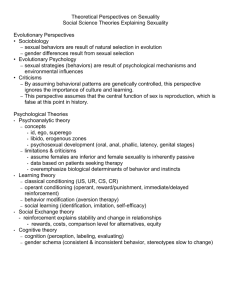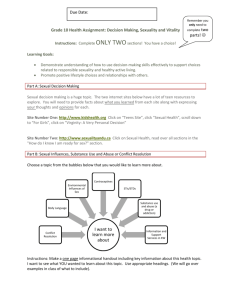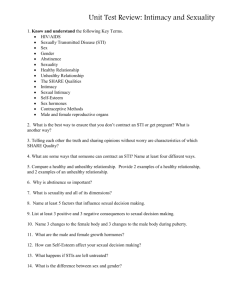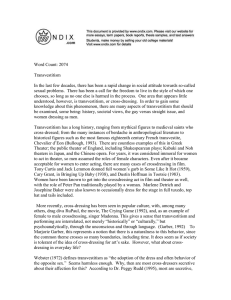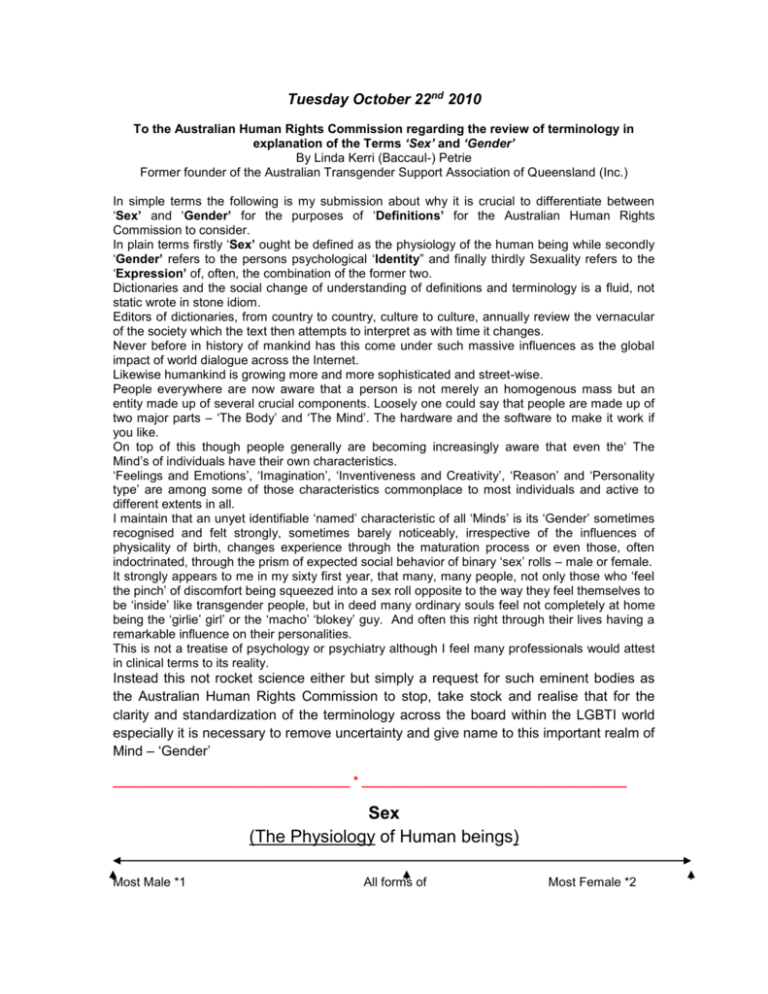
Tuesday October 22nd 2010
To the Australian Human Rights Commission regarding the review of terminology in
explanation of the Terms ‘Sex’ and ‘Gender’
By Linda Kerri (Baccaul-) Petrie
Former founder of the Australian Transgender Support Association of Queensland (Inc.)
In simple terms the following is my submission about why it is crucial to differentiate between
‘Sex’ and ‘Gender’ for the purposes of ‘Definitions’ for the Australian Human Rights
Commission to consider.
In plain terms firstly ‘Sex’ ought be defined as the physiology of the human being while secondly
‘Gender’ refers to the persons psychological ‘Identity” and finally thirdly Sexuality refers to the
‘Expression’ of, often, the combination of the former two.
Dictionaries and the social change of understanding of definitions and terminology is a fluid, not
static wrote in stone idiom.
Editors of dictionaries, from country to country, culture to culture, annually review the vernacular
of the society which the text then attempts to interpret as with time it changes.
Never before in history of mankind has this come under such massive influences as the global
impact of world dialogue across the Internet.
Likewise humankind is growing more and more sophisticated and street-wise.
People everywhere are now aware that a person is not merely an homogenous mass but an
entity made up of several crucial components. Loosely one could say that people are made up of
two major parts – ‘The Body’ and ‘The Mind’. The hardware and the software to make it work if
you like.
On top of this though people generally are becoming increasingly aware that even the‘ The
Mind’s of individuals have their own characteristics.
‘Feelings and Emotions’, ‘Imagination’, ‘Inventiveness and Creativity’, ‘Reason’ and ‘Personality
type’ are among some of those characteristics commonplace to most individuals and active to
different extents in all.
I maintain that an unyet identifiable ‘named’ characteristic of all ‘Minds’ is its ‘Gender’ sometimes
recognised and felt strongly, sometimes barely noticeably, irrespective of the influences of
physicality of birth, changes experience through the maturation process or even those, often
indoctrinated, through the prism of expected social behavior of binary ‘sex’ rolls – male or female.
It strongly appears to me in my sixty first year, that many, many people, not only those who ‘feel
the pinch’ of discomfort being squeezed into a sex roll opposite to the way they feel themselves to
be ‘inside’ like transgender people, but in deed many ordinary souls feel not completely at home
being the ‘girlie’ girl’ or the ‘macho’ ‘blokey’ guy. And often this right through their lives having a
remarkable influence on their personalities.
This is not a treatise of psychology or psychiatry although I feel many professionals would attest
in clinical terms to its reality.
Instead this not rocket science either but simply a request for such eminent bodies as
the Australian Human Rights Commission to stop, take stock and realise that for the
clarity and standardization of the terminology across the board within the LGBTI world
especially it is necessary to remove uncertainty and give name to this important realm of
Mind – ‘Gender’
__________________________________ * ______________________________________
Sex
(The Physiology of Human beings)
Most Male *1
All forms of
Most Female *2
Chromosomal, Genetic, or Hermaphroditic psychological difference.*3
*1). ‘Most Male’ and *2. ‘Most female’ for example can be commonplace seen exhibited
throughout society. They will largely be for example as a result of Testosterone levels in males
and Estrogen levels in Females and often in obvious physiological of secondary sexual
characteristics are features that distinguish the two sexes of a species, but that are not directly
part of the reproductive system. They are believed to be the product of sexual selection for traits
which give an individual an advantage over its rivals in courtship and aggressive
interactions.[citation needed] They are distinguished from the primary sex characteristics: the sex
organs, which are directly necessary for reproduction to occur. These may be thick-set features in
males (jaw line etc.) or obvious development in females (Breasts, fatty tissue spread e.g.).
It is important to touch on differences between personality ‘Expression’ and physiological
‘Characteristics’
It is often socially wrongly historically assumed for example that the most ‘blokey’ of men will be
aggressive and that the most voluptuous of women will tend towards promiscuity.
We all have experienced in life stories of ‘the gentile giant’, ‘the best and fairest’ on the football
field and thankfully the realization that all voluptuous ‘Blondes are ‘dumb’.
In parallel the mythology around all ‘Gay’ men being ‘limp wristed fairies’ is debunked by
observing ‘gay bears’ (gay men who collect sporting their beards and bulk proudly) or that all
Lesbians are ‘Butch’. One only has to observe Lesbian magazines to see that this is not the case
or for example Ellen DeGeneres’s beautiful curvaceous Australian wife
*3). These differences may include for example - Klinefelters or Turners Syndromes XY
chromosomal differences; Androgen Insensitivity among many others resultant usually from birth.
i
Again it is important to note that the medical physiological differences do not denote anticipated
‘Standard’ ‘Expressions’ as a result.
I have for example encountered apparently outwardly biologically ‘male’s with Klinefelter’s
Syndrome (Instead of the normal XY chromosomes, these individuals have and extra X
chromosome making them XXY. ) describing varying degrees of expression in attraction to the
opposite or both sexes.
Meanwhile it is apparent that the outward expression of males and females with Androgen
insensitivity syndrome (AIS) may be ‘Expressed’ differently in the individual since AIS is largely
divided into three categories differentiated by the degree of genital masculinisation – 1. complete
androgen insensitivity syndrome (CAIS) is indicated when the external genitalia is that of a
normal female 2. mild androgen insensitivity syndrome (MAIS) is indicated when the external
genitalia is that of a normal male, and 3. partial androgen insensitivity syndrome (PAIS) is
indicated when the external genitalia is partially, but not fully masculinised.
Likewise in other human beings their outward expression, anticipated by degree of
masculinisation and feminization may also vary according to the individuals reaction to their
hormones or cyclical hormone release in females.
__________________________________ * ______________________________________
‘Gender/ Gender identity’
(The Characteristic of Human ‘Self-Perception’)
Most Male *1
All forms of
Most Female *2
personal ‘Gender Difference’ (e.g. also ‘Bigender’ and ‘Agender’)
*1). ‘Most Male’ to *2. ‘Most female’ and every form of self expression in between –
Here we may be talking about not only the experience of the ‘Primary Gender’ transsexual
‘Difference’ who is convinced that “they are ‘inside’ the gender opposite to that of their birth sex
from their earliest possible recollections”ii,for example, but in deed also the self perception of
ALL individuals on this linear scale be they those born typically physically male or female or
those with genetic, chromosomal or other physiological differences.
An androgyne (Androgyny-ous/GenderQueer) in terms of gender identity, is a person who does
not fit cleanly into the typical masculine and feminine gender roles of their society. They may also
use the term ambigender to describe themselves. Many androgynes identify as being mentally
"between" woman and man, or as entirely genderless. They may identify as non-gendered,
genderneutral, gendered, between genders, intergendered, bigendered, pangender or gender
fluid.
‘Genderqueer’ is sometimes adopted by individuals as an umbrella term.
In social application this term may also refer as in fashion, sexual identity, or sexual lifestyle, or it
may be true hermaphrodite physicality.iii
Bigender or bi-gender (bi+gender)
Transgender/Transsexual:
I believe it is important to spell out and clarify the use of the term ‘Transsexual’.
For this purpose I believe that th Australian Human Rights Commission ought refer to and
adopt the existing definitions given by those medical teams, such as the Monash University’s
Center for Adult Psychiatry Gender (sex) Reassignment team, the Sydney “Gender Centre’ and
other’s specializing in assessment and surgical sex reassignment.
An Important contemporary example of confusion with regard to ‘Sex’ and
‘Gender Terminology’:
Here from the social on-line encyclopedia Wikepedia the explanation for the definition of the term
‘Bigender’ shows clearly the confusion that can arise through incorrect application of any
standardization of terminology in the importance of delineating the difference between the realms
of ‘Sex’ and ‘Gender’ through the added understanding of the difference between self
‘Expression’ and self ‘Identity’
Note, for example the Wikepedia definition describes ‘Bigender’ “as a tendency to move
between feminine and masculine gender-typed behaviour depending on context, expressing a
distinctly "en femme" persona and a distinctly "en homme" persona, feminine and masculine
respectively”, yet at the same time citing that “A 1999 survey conducted by the San Francisco
Department of Public Health observed that, among the transgender community, less than 3% of
those who were genetic males and less than 8% of those who were genetic females identified as
bigender”.
Identified’? in other words what is being described is clearly an attribute of gender identity.
The definition is all over the place with ‘Gender’ being contingent on ‘’Behavior” (i.e. ‘Expression’
rather than ‘Identity’) while ‘Sex’ is solely defined as being based on ‘Genetics’ (psychological
sex’)alone although there is in reality there is nothing to prevent individuals with fluid Bigender
self perception emerging from either transgender, or male or female gender backgrounds even as
the statistics cited suggest. In deed those it is not uncommon for those with Klinefelters
Syndrome having bigender even day to day or hour to hour fluid bigender perception of self.
Wikepedia the goes on to explain, “While an androgynous person retains the same gender-typed
behaviour (should be self-perception’) across situations, the bigendered person consciously or
unconsciously changes their gender-role behaviour (should be gender self perception or gender
identity) from primarily masculine to primarily feminine, or vice versa iv (but I would add the caveat
of but always only male or female)
Conclusion Re ‘Bigender’: clearly where what Wikepedia describes here with the ‘fluidity of
behavior” personal between male and female would be more accurately described as ‘Bisexuality’
whereas ‘Bigender’ describes persons who ‘fluidly’ sometime identify as male and other times as
females, or indeed, neither in particular.
__________________________________ * ______________________________________
NOTE: Gender Queer, Trans, Transvestitism:
I include this group for discussion in between the explanations of
‘Gender/Gender Identity’ and ‘Sexuality’ (which follows) because of the
conundrum raised from some individuals concerned, as well as the
historic difficulty the mainstream community has had across the recent
decades trying to understand the nuances therein.Transvestitism and ‘Drag Queens’: The area of transvestitism is a contentious
one especially for those who insist that the focus of understanding of the
phenomenon ought be on it being another form of their ‘Gender Identity’ rather
than focus on the “Sexual Expression”. (I include a synopsis of Transvestitism
and its history at the endv)
- The nub of the conundrum which arises as problematic is A). that often the first emergence of transsexuals or those whose transgender
experience is more because of their experience of ‘Inner Gender Identity
difference’ often emerge from the ranks of transvestite clubs catering to those
who express their sexuality through transvestitism (often with spouses in tow)
quite often but not exclusively heterosexual men; while others quite often but not
exclusively homosexual guys from the ‘Gay’ clubs and venues ‘Drag’ show
circuits also are first port of call for those who likewise emerge as those with their
‘Inner Gender Identity differences’ from there;
B). that Transvestites who go out into the public arena cross-dressed where
their gender or their right to dress, present, or express themselves they way they
like in public may be challenged in law.
And
C). that some few who express themselves through cross-dressing are
comfortable acknowledging and living with that their difference is simply an
“Expression’ of their sexuality through ‘transvestitism’ and do so proudly, while
others feel that their difference in cross-dressing, (part or a lot of the time) is
more to do with a deeper ‘Experience’ of the ‘feminine side of their persona’ or in
other words more akin to their ‘Gender Identity’.
Any assessment is subjective.
Consequences- ‘DOCUMENTAION’
However the differences in potential consequences in Law between these
differing types of individuals cited above, for example, the Transvestite
challenged by Police on a night out, the transitioning Transsexual facing
incarceration, or in deed challenge by authorizes overseas, or the Gender-Queer
experiencing a deeper form of gender difference either pulled up by police or
facing incarceration are drastically different in implication.
No where is the issue of documentation more crucial with regard to the debate
about transitioning transsexuals both here and abroad.
The plain facts of the matter avoided, shelved in the ‘too hard basket’, the
elephant in room in fact, are that
1). Individuals who experience themselves of the gender opposite/different to
their sex MUST not be obliged to undergo surgery merely for the convenience of
the a medical-solution-to every-problem mad society and its arcane binary malefemale way of human kind.
2). The genuine surgically contra-indicative reasons for individuals who
experience themselves of the gender opposite/different to their sex but can
nevertheless not be able to undergo surgery must not be given as legitimate
reason for them not to be legally recognised as having the gender of the opposite
sex and being given documentation to that effect, merely for the convenience of a
myopic society and its arcane inability to understand human kind through none
other than the binary prism of male or female.
3). Individuals who experience themselves of the gender opposite/different to
their sex
ought be afforded financial support for requested Gender
Reassignment surgery where there is little likelihood of them being able to afford
it, this especially since many may be unable to enter their required career due to
the constraints of not being able to pass as their gender.
__________________________________ * ______________________________________
‘Sexuality’
(Sexual Preference/Attraction/Orientation/Behaviour)
Most Male *1
All forms of
personal ‘Sexual Orientation’ or ‘the sex of
‘the person/s’ the subject is attracted to.
Most Female *2
Human male sexuality –
Human male sexuality encompasses a broad range of issues, including male sexual desires and
behaviors, as well as the physiological, psychological, social, cultural, political, spiritual, and
religious aspects of sexuality. Various aspects of male sexuality, as a part of human sexuality,
have also been addressed by principles of ethics, morality, and theology. Throughout history, the
arts have presented a substantial portion of a given culture's view towards human sexuality. In
most societies, there are legal bounds on what sexual behavior is permitted. Sexual norms vary
across cultures and regions, and they have continually changed throughout history. For example,
in ancient Greece, most males participated in romantic and sexual relationships with other males,
as it was considered a universal and mainstream part of manhood. Sexual relationships with
females, on the other hand, were generally restricted to reproduction. vi
Asexuality
Asexuality (also known as nonsexuality), in its broadest sense, is the lack of sexual attraction or
the lack of interest in and desire for sex. Sometimes, it is considered a lack of a sexual
orientation. One commonly cited study placed the incidence rate of Asexuality at 1%. Asexuality
is distinct from abstention from sexual activity and from celibacy, which are behavioral; the latter
is usually, but not always, for a religious reason.(For instance, sexual people in relationships with
asexuals may become celibate as a result.) Asexual orientation, unlike a behavior, is definitionally
"enduring". Some asexuals do have sex, despite lacking a desire for it. vii
Bisexuality: being attracted to people of either the same or opposite sex. But neither necessarily
inclusively at the same time nor exclusive of the other.
Monogamy: Engaging with the one partner only by arrangement/agreement (i.e. socially
registered/’Married’) for a period of time of coupling for life;
Homosexuality: Being ‘Gay’ or ‘Lesbian’ having attraction to the same sex as one self.
Others: Bestiality, Masochism, Narcissism etc.
END NOTES:i
http://en.wikipedia.org/wiki/Klinefelter's_syndrome
Definition by Prof. Steinbeck, Newcastle University from ‘TRANSSEXUALISM AND SEX
REASSIGNMENT’ edited by Prof. William A. W. Walters and Dr. Michael W. Ross, (oxford
University press Melbourne 1991) two of the founders of the Monash Medical Centre Adult
Psychiatry Unit Victorian gender Reassignment program.
ii
iii
http://en.wikipedia.org/wiki/Androgyny
iv
http://en.wikipedia.org/wiki/Bigender
v
Transvestitism:
History
Although the word "transvestitism" was coined as late as the 1910s, the phenomenon is not new.
It was referred to in the Bible and traces back to Ethiopia and the origin of man. The word has
undergone several changes of meaning since it was first coined. It is still used in a variety of
senses. Therefore, it is important to determine, whenever the word is encountered, in which
particular sense it is used. However, to understand the different meanings of "transvestitism", it is
necessary to explain the development of the term.
Origin of the term
Magnus Hirschfeldv coined the word "transvestitism" (from Latin trans-, "across, over" and
vestitus, "dressed") to refer to the sexual interest in cross-dressing. He used it to describe
persons who habitually and voluntarily wore clothes of the opposite sex. Hirschfeld's group of
transvestites consisted of both males and females, with heterosexual, homosexual, bisexual, and
asexual orientations.
Hirschfeld himself was not happy with the term: He believed that clothing was only an outward
symbol chosen on the basis of various internal psychological situations.[citation needed] In fact,
Hirschfeld helped people to achieve the very first name changes (legal given names were and are
required to be gender-specific in Germany) and performed the first reported sexual reassignment
surgery. Hirschfeld's transvestites therefore were, in today's terms, not only transvestites, but
people from all over the transgender spectrum.
Hirschfeld also noticed that sexual arousal was often associated with transvestitism. In more
recent terminology, this is called autogynephilia. Hirschfeld also clearly distinguished between
transvestitism as an expression of a person's "contra-sexual" (transgender) feelings and
fetishistic behavior, even if the latter involved wearing clothes of the other sex.
Cross-dressers/Cross-dressing
After all the changes that took place during the 1970s,[clarification needed] a large group was left
without a word to describe themselves: heterosexual males (that is, male-bodied, male-identified,
gynephilic persons) who wear traditionally feminine clothing. This group was not particularly
happy with the term "transvestitism". Therefore, the term "cross-dresser" was coined.[citation
needed] Self-identified cross-dressers generally do not have fetishistic intentions, but are instead
men who wear female clothing and often both admire and imitate women.
This group did — and sometimes still does — distance themselves strictly from both gay men and
transsexuals, and usually also deny any fetishistic intentions. It was probably this development
that led to the explicit definition of Transvestitic fetishism as distinctively different from
transvestitism.
However, when this group of people achieved public attention,[citation needed] they were
commonly referred to as transvestites rather than cross-dressers. That led, paradoxically, to yet
another usage of transvestitism: cross-dressing, male-bodied, male-identified, heterosexual
persons. This group typically self-identifies as "cross-dressers".
Echoing the changing history of the term "transvestitism", cross-dressing (but not cross-dresser)
is now being used to describe the act of wearing clothing of another gender.
When cross-dressing occurs for erotic purposes over a period of at least six months and when it
causes significant distress or impairment, the behavior is considered a mental disorder in the
Diagnostic and Statistical Manual of Mental Disorders called Transvestitic fetishism.
vi
http://en.wikipedia.org/wiki/Human_male_sexuality
vii
http://en.wikipedia.org/wiki/Asexuality






